It was common practice to weld T'sentraedi and other Mecha armor over a few critical points, though not all "end users" did this, and no two ever ended up exactly alike.
Nominal Moddies were pathetic constructs, to be sure, home built things more akin to Junkyard Wars than the Reconstruction Wars, and most couldn't make it out of their garages (would you believe most of these bandits actually had the gall to refer to these buildings as "Mecha hangars"?!), but not ALL were so humble of nature.
RDF Mecha are preferred as a general rule of thumb, due to the large number floating around, their adaptability, and the ease with which clones have been mass-produced.
Note: All references to cost and availability refers to the black market. Costs for "original" equipment is not listed. Upgrading from RDF-era armor to REF-era armor costs between 10,000 and 25,000, and applies to RDF-era Mecha only. ASC-era Mecha can NOT have armor upgrades (won't fit correctly).
For our purposes here, no moddy that ever saw service with a military as a working design will be discussed (to avoid repetition).
REF Moddies weren't as versatile versus their RDF predecessors, as the REF designs were highly structuralized; Little modification could be done to them. However, some Moddies were done, to varying degrees of success. Only the TBP Z-1 had much room for improvement (a side effect of the limited design it originally had).
With a few noteworthy exceptions, moddies that later become production-line REF lines (under the PPC, IPA, UWA, or UGC) are NOT listed here to avoid repetition.
General Moddies.
Queen Anne's Justice
Queen Anne's Enforcer
LightBringer
"Crab" Gun-Tanks
Gun Trucks
Dealer Gulag Moddy
Camp One
Outriders
AquaTech100 "Coastal Invader" Kayak
Thresher
"Badger" Hovertank
"The Mayflower."
Unnammed MAC II Moddies
"Dragon" Hovercycle Moddy (Ted MCCAIN, Human)
Weapons Moddies
Second-generation Zatoichi
Because not every idea is a GOOD IDEA; Some were funny, but most were pathetic.
AT-ST series
Ostcout
Ostroc
Ostsol
AT-AT
Bombardier
Badass
Stalker
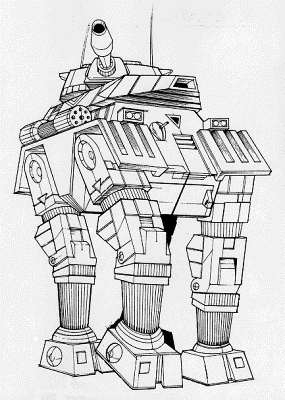 Junker was the code name for any of a great variety of tanks with legs. Usually they weren't even really tanks, but armored cars. The theory, at least, was simple- Put 04 legs on a tank and you don't have to worry about inconveniences like roads. Of course, they never quite lived up to their own hype, and invariably they were put down.
Junker was the code name for any of a great variety of tanks with legs. Usually they weren't even really tanks, but armored cars. The theory, at least, was simple- Put 04 legs on a tank and you don't have to worry about inconveniences like roads. Of course, they never quite lived up to their own hype, and invariably they were put down.One of the more effective ones I saw (at the Kyhron Kravshevva Military Museum, Terra) was a Russian armored car with Destroid legs. The legs appeared to be from an Excaliber, but the missile pods at the time of capture were inactive (the control and power feeds were burned, indicating they were never going to be hooked up). While this Junker config SOUNDS pathetic, it's display case spoke for itself- 03 VT-1's, 05 Gladiators, and a MAC-II killed, PLUS 2 Excalibur's forced to disengage. Indeed, the operation to neutralize the Junker ("Roundhouse") was one of the most abysmal failures of the Hopscotch Campaigns (the effort to neutralize all unauthorized Mecha down in South America). The example unit shown here also had Excalibur-style MRM pods straddling the main engine box.
Nominal Junkers had Tactical Battle Pod legs reinforced with extra armor. Occasionally an additional missile pod would be included.
Name: Junkers Walking Tank
Model Type: Moddie/Tank with Destroid and other legs.
Class: Moddie/Outlaw Tech
Crew: Varies by specifics- The baseline model had a crew of 3.
Passengers: Normally none.
M.D.C. By Location:
Crew Compartment-
Upper Legs (4)-
Lower Legs (4)-
Turret-
50
30 each
30 each
50
Turret Laser Gun-
25MM Cannon (on top of turret)-
Missile Pods (2)-
5
10
50
Speed and Statistical Data:
Range On Land: 500 Miles
Surfaced On The Water: 60 knots
Range On The Surface: 600 Miles
Height: 40 ft
Width: 15 ft
Length: 25 ft
Cargo: Only crew supplies could be carried internally. However, several sacks and tools had been tied to the outside.
Power System: 4 jet engines.
Flight System: T'sentraedi style grav pods
Cost and Availability: Between 2,500 and 25 millioncredit, depending on quality; Extremely common.
Purpose: Assault
MD: 5D10+25 per blast
Rate of Fire: Twice per melee max
Range: 4,000 feet
Payload: 10 blasts max per charge.
Cost: 50,000credit each.
Availability: Routinely available
2. Coaxial Laser Rifle: Actually a modified RDF Heavy Energy Rifle. Mostly used for targeting.
Purpose: Targeting/Offense
MD: 1D6
Rate of Fire: Per gunners attacks per melee.
Range: 900 feet
Payload: Unlimited. This was one of those rare occasions when power wasn't an issue.
3. Twin Missile Launchers: Scrounged off of RDF Excalibur's. This particular variant was modified to utilize T'sentraedi MRM's.
Purpose: Assault
Missile Type: Any T'sentraedi MRM
M.D. and Range: Varies by type used
Rate of Fire: Volleys of 1 or 2 per melee.
Payload: 6 per launcher; 12 total.
Cost: 12,000credit each
Availability: Occasional.
Purpose: Defense/Anti-Personnel
MD: 2D8 for impact, 1D6 for explosion (when using explosive of depleted uranium rounds)
Rate of Fire: Per pilots attacks per melee
Range: 4,000 feet
Payload: 2,400 rounds; 100 full melee bursts, 200 long bursts, and 400 short bursts.
Cost: 5,000credit each.
Availability: Routinely available
5. Twin Missile Launchers: Scrounged off of RDF Excaliber's. This particular variant was modified to utilize T'sentraedi MRM's.
Purpose: Assault
Missile Type: Any T'sentraedi MRM
M.D. and Range: Varies by type used
Rate of Fire: Volleys of 1 or 2 per melee.
Payload: 6 per launcher; 12 total.
Cost: 12,000credit each
Availability: Occasional.
6. Hand to Hand Combat: Not a very effective option; However, it COULD do some damage.
Kick/Stomp- 1D6 M.D. (only effective against small objects)
Body Block: 2D6 MD.
- Radar: Civilian grade radar. Range 100 miles, can track up to 50 individual targets. 85% reliability.
- GPS: Standard tracking device.
- HUD: Displays maps, radar, targeting information, and any OTHER information the wearer wants directly in front of the user.
- Virtual Map: Displays a continuously-updating map of local terrain for the pilot. Effective land navigation of 85% as updates come. Good to 50 miles. Specific range can be adjusted in 1 mile increments.
- Loudspeaker: Amplifies voice 1 to 100 times. 100' in normal crowds.
- Survival Pack: A pack of simpler emergency survival supplies: Pup tent, sleeping bag, black light, GPS, first aid kit (bandages, gauze, bandage tape, pads, antiseptic/analgesic), plasma torch (for small repairs and starting fires), repair kit (with M.D.C. Repair Spray), sewing kit (a small spool of thread and 5 needles), 1 star flares (250' apogee), 2 white parachute flares (1,500' apogee), 100' of black or brown parachute cord (150 lbs tensile strength), 2-5 days rations, 2 gallons water, water purification kit- good for about 10 gallons. These were stowed in pouches tied to the hull.
- Combat Bonuses from Junker Combat Elite:
- None. Moddies were notoriously lacking in advanced combat abilities.
RETURN TO TOP OF PAGE
With power like this, you'd think this WAS his power. You'd think wrong. He'd use the Justice to disable a ship, then use the Queen Anne's Enforcer to board her. And the Enforcer was the TRUE power of the ship.
Name: Queen Anne's Justice
Model Type: Moddie/T'sentraedi shuttle pod with weapons attachments.
Class: Moddie/Outlaw Tech
Crew: Ship's Crew: 4 Boarding Party: About 15.
Passengers: Only a few.
M.D.C. By Location:
Crew Compartment-
Laser Turrets(3)-
150
50 each
Propeller Screws (2)-
Cargo Doors (2, on each side of the hull)-
75 each
50 each
Maximum Height: 2,000 Feet
Range In The Air: No Known Limit
Surfaced On The Water: 50 knots
Range On The Surface: No Known Limit
Underwater: 21 knots
Maximum Depth: 200 feet
Range Underwater: No Known Limit
Space: No Longer Possible
Width: 80 feet
Length: 200 feet
Weight: 80 tons minus cargo.
Cargo: 15 tons.
Power System: A pair of Xot'Zerr-5a-DCr's
Flight System: T'sentraedi style grav pods
Cost and Availability: A similar unit would cost between 2,500 and 25 millioncredit/One of a kind, so far as anyone knows.
Purpose: Disabling/Intimidation Fire
MD: 1D6 times 20 MD
Rate of Fire: Once per melee.
Range: 30 miles. However, they were never used at more than 10 miles, and rarely over 2 miles.
Payload: Unlimited. They drew very little power from the modified reactors.
Cost: One would fetch around 60,000credit
Availability: Rare; Normally one would have to go and find one of their own.
Purpose: Disabling fire.
MD: Two settings: Single Fire: 1D4 times 10 per blast; Burst Fire: 3D4 times 10 per blast
Rate of Fire: Equal to the number of combined attacks of the gunner.
Range: 4000 feet
Payload: Unlimited.
Cost: One would fetch around 16,000credit
Availability: Rare; Normally one would have to go and find one of their own.
Even more so than MOST Moddies, the Queen Annne's Justice hade very few features:
- Radar: Civilian grade radar. Range 100 miles, can track up to 50 individual targets. 85% reliability.
- GPS: Standard tracking device.
- HUD: Displays maps, radar, targeting information, and any OTHER information the wearer wants directly in front of the user.
- Loudspeaker: Amplifies voice 1 to 100 times. 100' in normal crowds.
- Combat Bonuses from Queen Anne's Justice Combat Elite:
- None. Moddies were notoriously lacking in advanced combat abilities.
RETURN TO TOP OF PAGE
Name: Queen Anne's Enforcer
Model Type: Moddie/T'sentraedi Glaug Officer's Pod with Micronian attachments and weapons re-outfitting.
Class: Moddie/Outlaw Tech
Crew: 1
Passengers: None.
M.D.C. By Location:
Crew Compartment-
Upper Arms (2)-
Normal Right Arm-
Modified Left Arm-
Upper Legs (2)-
100 (armor added to the outside of the cockpit)
40 each
50
25
40 each
Main Jet Engines (2)-
Laser Rifles (3)-
Heavy Laser Rifle-
M-89 Turret-
M-89 GatlinGun-
25 each
10
15
20
25
Range On Land: No Known Limit.
Flying: 600 MPH
Service Ceiling: 5,000 feet
Range In The Air: No Known Limit.
Surfaced On And Underwater: 10 Knots
Range On The Surface: No Known Limit.
Maximum Depth: 20 feet
Range Underwater: No Known Limit.
Maximum Dive Time: 10 hours on closed air; Unlimited on snorkel.
Space: No longer Possible.
Width: 25 feet 6 inches
Length: 28 feet 4 inches
Weight:
Cargo: Only crew supplies could be carried internally. However, several sacks and tools had been tied to the outside.
Power System: 1 Roiquonmi reactor; Output: 3.9 GGV; Lifespan: Unknown; The tinkering done on Enforcer had caused the reactor to degrade, but tinkering on the reactor itself had seemed to repair the damage. Either way, the unit was captured LONG before the reactor would have failed.
Flight System: T'sentraedi style grav pods
Cost: A similar unit would cost between 2,500 and 25 millioncredit.
Availability: One of a kind, so far as anyone knows.
Purpose: Anti-Personnel/Intimidation
Damage: 5D6 SD
Rate of Fire: Per pilots attacks per melee.
Range: 2,000
Payload: Unlimited.
Cost: 6,000credit.
Availability: Occasional.
2. RDF Heavy Laser Rifle: Mounted fixed-forward to supply some heavy hitting anti-personell capability.
Purpose: Intimidation/Disabling Fire
MD: 1D6
Rate of Fire: Per pilot's attacks per melee.
Range: 900 ft
Payload: Unlimited.
Cost: 8,000credit.
Availability: Rare.
3. M-89 Gatling Gun: Blackjack elected to use a Commanchero-style M-89 gatlings, mounted on a turret mounted on the underside of the Mecha, in much the same way a VF-1's head laser is.
Purpose: Disabling Fire
MD: 3D4 for a short burst, 6D4 for a long burst, 6D6 for a full melee burst.
Rate of Fire: 6 short bursts, 3 long bursts, or 1 full melee burst per melee.
Range: 2,000 ft
Payload: 1,200 rounds; Full melee burst uses 40 rounds, long burst 20, short 10.
Cost: 50,000credit.
Availability: VERY rare.
4. Right Weapon Arm: A dual weapon system that came with the original pod. On the rare occasion Capt Jackson sought only to kill and destroy, this was his preferred weapon.
Particle Beam Cannon: Used only to destroy; He preferred to use the auto cannon to kill.
Purpose: Assault
MD: 4D10 MD
Rate of Fire: Equal to pilots attacks per melee.
Range: 4,000 feet
Payload: Unlimited.
Auto Cannon: Used only to kill people; He preferred to use the PBC to break things.
Purpose: Anti-Personnel
MD: 2D6 MD
Rate of Fire: Equal to pilots attacks per melee.
Range: 2,000 feet
Payload: 50 blasts nominally; Actual payload varied over time, however he always had a few dozen or so bursts locked and loaded.
Purpose: Assault/Intimidation
MD: 4D10 MD
Rate of Fire: Per gunners attacks per melee
Range: 6,000 feet
Payload: Unlimited.
Cost: 15,000credit.
Availability: Rare; Normally one would have to go out and find one of their own.
6. 6 SRM's: Used sparingly, as Capt Jackson preferred to use their other weapons normally.
Purpose: Assault/Disabling Fire
Missile Type: Any T'sentraedi SRM
MD and Range: Varies by type used
Rate of Fire: Volleys of 1, 2, 3, 4 and 6 missiles
Payload: 6 missiles max. He usually only had 3 or 4, but always seems to have some.
7. Hand to Hand Combat: Not Capt Jackson's preferred form of combat, though he was known to pound on the decks of "interned" cargo vessels from time to time.
Kick- 1D6
Punch- 1D6
Leap Kick- 2D6
Stomp- 1D6 (only effective against small objects).
- Radar: Civilian grade radar. Range 100 miles, can track up to 50 individual targets. 85% reliability.
- GPS: Standard tracking device.
- HUD: Displays maps, radar, targeting information, and any OTHER information the wearer wants directly in front of the user.
- Loudspeaker: Amplifies voice 1 to 100 times. 100' in normal crowds.
- Virtual Map: Displays a continuously-updating map of local terrain for the pilot. Effective land navigation of 85% as updates come. Good to 50 miles. Specific range can be adjusted in 1 mile increments.
- Periscope: A WWII periscope based on one designed for the Russian Navy. The design was modified for use by the Queen Anne's Enforcer. The periscope was used to train the M-89 for submarine attack.
- Combat Bonuses from Queen Anne's Enforcer Combat Elite:
- None. More so than most, the modifications on Queen Anne's Enforcer negated any bonuses, and in fact made it harder to fight: -2 strike, -5 dodge, and -3 parry.
RETURN TO TOP OF PAGE

The power plant was derived from a normal locomotive engine. The fuel tanks were slung underneath, and both components covered with scrounged armor (scrounged from T'sentraedi re-entry pods, rather than the more common Mecha armor).
This particular unit was actually an RDF vehicle, the pet project of the CO at Canaveral Aero-Space Base, and used as an ammo carrier in Florida for about 6 months. Though this particular unit was not a qualified success, many others, mostly built by outlaws and mercenries, were.
Lightbringer's historical influence should not be casually dismissed; Between her and Thresher, the basic theories necessary for the eventual development of the UGC Landships, even if Louisa was the first major landship.
Name: Lightbringer.
Model Type: Moddie/Flatbed truck with T'sentraedi Tactical Battle Pod on a turret.
Class: Moddie/RDF Ammo Carrier.
Crew: 5; Commander (usually a sergeant), driver and auxiliary driver, gunner, and engineer. Most outlaw versions had a crew of 2 to 4.
Passengers: Normally none.
M.D.C. By Location:
Crew Compartment-
Wheels (46)-
TBP Turret-
200
75 each
75 (additional armor inside)
Laser Gun (on top of turret)-
Hatches (4)-
10 each
50 each
Range Over Land: 600 Miles.
Height: 15 feet.
Width: 35 ft.
Length: 150 feet.
Weight: 50 tons.
Power System: 1 Roiquonmi reactor scrounged from an Officer Battle Pod.
Drive System: 46 hard rubber tires on split-gear drive system (like tanks).
Cost and Availability: Between 50,000 and 25 millioncredit, depending on quality/Extremely common.
Purpose: Assault.
MD: 4D10 MD.
Rate of Fire: Per gunners attacks per melee.
Range: 6,000 feet.
Payload: Unlimited.
2. Top Mounted Laser Guns: Normal Tactical Battle Pod rear firing laser guns.
Purpose: Anti-Aircraft defense.
MD: 2D6.
Rate of Fire: Per gunners attacks per melee.
Range: 4,000 feet.
Payload: Unlimited.
MD: 3D4 for a short burst, 6D4 for a long burst, 6D6 for a full melee burst.
Rate of Fire: 6 short bursts, 3 long bursts, or 1 full melee burst per melee.
Range: 2,000 feet.
Payload: 1,200 rounds; Full melee burst uses 40 rounds, long burst 20, short 10.
- HUD Visored-Helmets: A specially designed version of the old-fashioned RDF pilots helmet is used both as a crash helmet AND as a frame for targeting systems and other equipment; Displays maps, radar, targeting information, and any OTHER information the wearer wants directly in front of the user. Ties into the toggle sight for gunners. The visor also has variable tint ability, adjusting to light conditions, up to an including a black dot if the sun is directly on the pilots face (only covers eyes), and when all else fails can be slid out of the way of normal vision. (Because the crew have little direct light on them inside the vehicle, this feature is not very useful, but the helmet comes that way.
Helmet Features:
Toggle Sight: Toggles the pilots vision to the sighting systems on the PBC's; When one cannon is targeted, the yellow crosshair for that side becomes a solid red crosshair; When both guns are targeted to the same object, the twin crosshairs become one red, blinking crosshair; The guns automatically recycle themselves to adjust for range.
FLIR: Forward Looking Infrared. Allows pilot to get visuals on targets at night. Note: "Forward" is relative to the direction the wearer is looking at that moment.
Full Range Sensory Systems: Infrared, Ultra Violet, Color Filters, and Thermal Imager: Range: 10 miles; Magnification: 40 times - GPS: Standard tracking device.
- Virtual Map: Displays a continuously-updating map of local terrain for the pilot. Effective land navigation of 85% as updates come. Good to 50 miles. Specific range can be adjusted in 1 mile increments.
- Survival Pack: A pack of simpler emergency survival supplies: Pup tent, sleeping bag, black light, GPS, first aid kit (bandages, gauze, bandage tape, pads, antiseptic/analgesic), plasma torch (for small repairs and starting fires) in small tool kit (with some simpler, often lost/broken parts and M.D.C. Repair Spray), sewing kit (a small spool of thread and 5 needles), 7 star flares (250' apogee), 7 white parachute flares (1,500' apogee), 1,000 feet of black or brown parachute cord (150 lbs tensile strength), 10 days rations, 5 gallons water, and water purification kit (good for about 10 gallons). The vehicle also had life rings due to it's proximity to water.
- E.S.M.: Radar Detector. Passively detects other radars being operated.
- Radar: Civilian grade radar. Range: 100 miles; Capability: Can track up to 50 individual targets. 95% reliability (00% against unfriendly stealthed vehicles, and only 10% against friendly ones). The radar has a display screen in the HUD Helmet Visor, but also has a second one in the right side saddlebag.
- Blue Force Tracker: Identifies friend from foe. Overlays the information on both the radar and HUD, ensuring that friendly forces are not accidentally targeted.
- GPS: Standard tracking device. Ties into the Blue Force Tracker.
- Anti-Jamming System: Reduces Electronics Countermeasure by 3/4 (decrease skill level appropriately).
- Decoys: Specially modified Mini-Missiles used as decoys; Burning globs of magnesium/aluminum alloy to confuse both radar AND heat sensory systems, as well as creating a lot of smoke to obscure the Mecha. Note: Though the modified mini-missiles combine smoke flares, AMC/FDs, and LDP's, they aren't powerful enough for use with Destroids/Guardians/Etc. Reduce effects by 20% against smart missiles (add +20% to rolls for smart missiles.)
Effect:
01-40: Enemy missile or missile volley detonates in chaff cloud - Missiles are all destroyed.
41-65: Enemy missile or missile volley loses track of real target and veers away in wrong direction (may lock onto another target).
66-00: No effect, missile is still on target.
Also note that the chaff cloud will also blind nearby heat sensors (and optically based sensors at night) for 1 melee. They will suffer the following penalties: Reduce melee attacks/actions, and combat bonuses by half. Also, a cloud of smoke approximately 252 feet.
Duration: 1D4 melee rounds.
Rate of Fire: Once per melee.
Payload: 6 chaff/flares. - Danglies: A worn out Beethoven CD (supposedly jammed police speed radar, not that any cop ever checked), a garter, a fuzzy die, and the commander, SSgt Alissa SKIDMORE'S High School and college graduation tassles. (And her garter.) The mirror was turned so the driver and assistant driver could check their hair as well.
- Combat Bonuses from Lightbringer Combat Elite:
- None. Moddies were notoriously lacking in advanced combat abilities. More so, the types of modification necessary to create a "Chariot" or "Crab" (as these were known as a class) typically made combat MORE difficult: -2 to strike and dodge, no parry (not possible), and rolling with impact meant rolling the vehicle and being stuck upside down.
RETURN TO TOP OF PAGE
With additional information by Corsarius
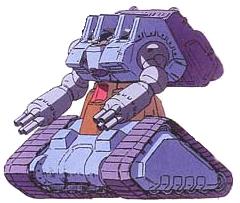
First seen in the fragmented Ukrainian Sector turning the Malcontent Uprisings, and occasionally seen after that, the "Crab" Gun-Tanks refers to any variety of tanks hull with Mecha Torso welded in. The singly most common combination is either the Black Knight or T-94 MBT hull with the T'sentraedi Nousjadeul-Ger Male Power Armor torso; Sub variants thereof abound, with the single most common of these being the replacement of the shoulder mounted cannons being replace with Katyusha-style calliope rocket packs. Though it is technologically possible, the arms of the Nousjadeul-Ger are NEVER replaced with gun pods, as this removes the gun tanks greatest asset, flexibility. The chest-mounted impact cannons are often replaced with or supplemented by various T'sentraedi weapons; The most common of these is to replace the impact cannon with Raditzs Regult Tactical Battle Pod PBC's.
The fact that the pilots is 1/100th the size of the original design fit, and that they are no longer inside the torso-come-turret anyways, means that the armor can be EXTENSIVELY rehabilitated to nearly 10 times as much as the original design; This makes the turret NEARLY as armored as the hull. Also, since the pilot's head is no longer protected by the helmet, the helmet can be replaced with a weapons configuration unit; Most common is the ROV-10 and the various models of VF-1 heads.
Though no one would argue that these are the fastest Mecha available, their crews had gotten quite adept at using the arms to knuckle walk the tanks out of bad ground conditions, erect camouflage nets in a hurry, and cable-pull themselves up steep embankments- One was even reported to be CLIMBING a mountain.
The basic theory of the Crab remains in the basic frame of the L-22 Rail Launcher; Though the L-22 uses the RDF Excalibur torso as its turret, and the M-406 as it's hull, the Crab was so successful a design that the REF fielded a few, under the cover story of mercenary forces, during the Malcontent Uprisings, and publicly fielded some captured from mercs and malconts. Now the L-22 is mounted in the turret, coming out where the cockpit used to be (they actually fire straight up). This official recognition of the effectiveness of this design, despite the relatively humble nature of it's birth and desperate nature of it's genesis, is a testament to the design. For this reason, they appear in the Moddies section.
The following is an official report from then TSSgt. TAALISMN:
| Additional information that was added latter by Sir Corsarius (an EBSIS soldier): |
Purpose: Assault
Missile Type: SRMs with MRM warheads.
MD and Range: Varies by type used.
Rate of Fire: Volleys of 1, 2, 3, or 4 times pilots attacks per melee.
Payload: 24 per launcher; 2 launchers max (stacked). Must be reloaded at a Mecha base.
Penatlies: Unlike most weapons, Katushas have a -3 to strike a specific target; To compensate, at least 12 must be fired together.
RETURN TO TOP OF PAGE
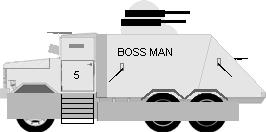 | 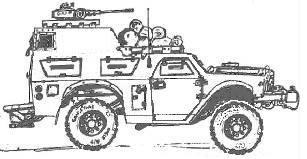 |
| "The Anarchists's" Truck Number 5, "Bossman". | An Officially Sanctioned RDF Gun Jeep (picture taken on Garuda). |
|---|
Class: Moddie/Gun Truck
Crew: 5; Driver, main gunner, and any additional gunners.
Passengers: About a dozen people could fit inside.
M.D.C. By Location:
Wheels (46)-
.50-cal Gun Turret (topside)-
.50-cal Guns (4)-
50 each
20
10 each
Side Doors (2)-
Gunports (10)-
Tactical Battle Pod Particle Beam (forward)-
100 each
10 each
20 each
Range Over Land: 600 Miles.
Height: 15 feet.
Width: 25 ft.
Length: 50 feet.
Weight: 5 tons.
Power System: a 5003 inch desiel engine.
Drive System: 10 rubber tires over wood weels reinforced with steel bolts.
Cost and Availability: Between 5-25,000 andcredit, depending on quality/Extremely common- Even the RDF and police departments had them, in quantity.
Purpose: Anti-Personnel/Armor
Damage: Lead (Ball) shot: 7D6 Per round; Depleted Uranium rounds: 1D6 times 10 MD per round; Can be single or burst fired.
Rate of Fire: Single Fire: 1 Shot per pilot's attacks per melee. Full Auto Fire: 5 round bursts per pilots attacks per melee. (Can actually fire up to 5,000 times per melee, but soldiers are trained to fire in 5 round bursts.)
Range: 600 feet
Payload: Up to 500 rounds can be carried easily.
Bonuses/Penalties: Can only be fired in 5 round bursts, to a maximum of 200 rounds per minute; Though the gun can EASILY cycle faster than that, it overheats the barrel, causing it to distort and bullets to jam inside of the barrel, causing a pileup in the barrel; This leads to barrel breach, and 1D6 MD to the gunner and anyone around him (regardless the ammo type).
Weight: 50 lbs
Weapon Cost and Availability: 5,000credit; Occasionally available. Highly sought after, and made by a wide number of black marketeers.
Ammo Cost and Availability: Ball rounds: 800 to 1,000credit for a box of 50; Routinely available; DU rounds: Up to 100 thousandcredit for a box of 50; Rare. Highly sought after.
Purpose: Assault
MD: 4D10 MD
Rate of Fire: Per gunners attacks per melee
Range: 6,000 feet
Payload: Unlimited.
3. Side Weapons: Any nuber of guns could be stuck out the side, though the 7.62 by 51MM NATO standard M134 Minigun was popular and available, along with "Fontain Heavies" and any other standard weapon. ther were two openings either side of the bed, plus two more in the half-rear panel and two more in the rear doors.
- CB Radio: General long-range comms with others. Easily intercepted and/or jammed.
- Cell Phone Curicuit: Unique among survivalist groups, the Anarchists had cell phones, tied into their own, PRIVATE relay. though it could be intercepted and jammed, few enemies took the time to do so. The jury-rigged nature of the equipment, however, left much to be desired on clarity and range. Range: About a mile.
- AM/FM Tapedeck: Major FONTAIN insisted it had to be a tape player, since he had a CD/Tape adapter.
- Lightbar: Roof-mounted yellow police style lightbar; Actually taken off a former police vehicle, the original blue lenses wer replaced with yellow ones.
- Portable Flagpole: About 40 feet tall at full extension. Ussually lied the American or California Repulic flags.
- Combat Bonuses from Gun Truck Combat Elite:
- None. Moddies were notoriously lacking in advanced combat abilities.
RETURN TO TOP OF PAGE
Dealer's road to Moddyville started with the recovery of an obsolete THUVERL DALEM-Class T'sentraedi Cruiser being used as a drogue (a minimally- or un-manned floating warehouse). About 2,000 Mecha of every major type was recovered. To expedite off-load, RDF Mechanical Engineers jury-rigged Mi'cronnian-Sized seats and controls, only rigged for basic propulsion. While off-loading, however, the group was attacked by T'sentraedi/Mi'cronnian Malcontents and were forced to abandon the site for a time. The Malconts took what they could as fast as they could; One of these would be a Gulag rigged as mentioned. The Malconts hurriedly completed sufficient modifications as were minimally necessary to make the weapons systems work, but this inevitably required a five man crew. Once recaptured six months later, the Mecha was re-equipped with twin 155MM howitzers fixed forward with autoloaders. Additionally, the main PBC topside was removed and replaced with a ROV-10 Laser turret, supplemented by a second one underside. Though in the end the 155MM's were determined NOT to be the ideal weapons load, the overall concept was recieved well. This configuration showed limited promise for post-Wars mass production, though it would require more work than was then practicable.
RETURN TO TOP OF PAGE
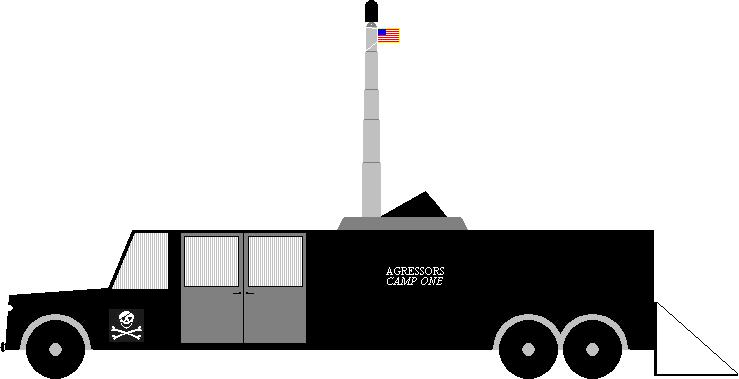
Along with all the Aggressor/Anarchist camp gear, Camp One was also used to haul tools, spare parts, and, most critically (most agree) the communications array built by Tom, Jer, Jim, Jenninie, and, strangely enough, Jessica, who was neither an Aggressor nor an Anarchist- Though she did work as the receptionist/nurse-in-training at Trinity hospital.
A normal cell phone repeater antenna, scrounged up in Redding, CA, was placed on a telescoping antenna salvaged from a TV News van. The clearance, 50', gave it more than enough height to clear most physical barriers in the areas the Anarchists operated in, at least for the mile to mile and a half they would work at any one time, ensuring continuous voice and video comms capabilities for the two militias. A fixed mast version of Camp One was also installed at Area One (the Daisyline hanger/landing strip) for the use of Securitat and other critical personnel.
Unlike many other moddies, however, Camp One did NOT really have much armor protection- Just light sheet steel plate over some of the more critical areas (such as the engine compartment), nor did she carry any fire power above a trio of Squad Automatic Weapons (SAW's), intended for self-defense during transit only (once in camp, the weaps were removed and assigned to fixed positions around the camp).
Despite the relatively humble nature of Camp One, everyone who worked by her operations swore that she was THE major lifesaver of the group, far in excess of Bossman, Biguns/Biguns II, or even You Lose. Major FONTAIN (well known to harbor a grudge against Aggressors in general) even praised the vehicle, and was known to ride in her during transit phases, in preference to his own You Lose.
Historical Data: Camp One began life as Shasta County Schools bus 871. She was a hybrid, using a fuel cell converter system to convert gasoline to hydrogen, giving her fairly good range per tank of gas. The Tommy Gate at the rear was installed after the switch of tools and parts from "The Shop" to "Camp One."
RETURN TO TOP OF PAGE
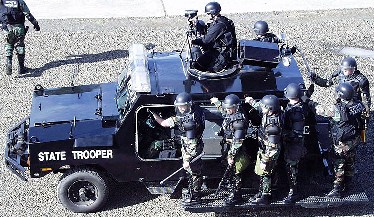 During the operations to restore order in Somalia, the warlord's forces shot down a few helicopters. In the confusion of the rescue effort, some soldiers were left behind, and were forced to run the "Mogadishu Mile."
During the operations to restore order in Somalia, the warlord's forces shot down a few helicopters. In the confusion of the rescue effort, some soldiers were left behind, and were forced to run the "Mogadishu Mile."To prevent this in the future, RDF ground vehicles were fitted out with outrider boards, modeled on standard police swat rigs, but in reverse; Rather than carry troops IN, these outriders provided a way to carry troops OUT. Generally about 8" wide and as long as the vehicle to which it's affixed, the outrider strips can be controlled by the DRIVER ONLY to be dropped to allow troops on or raised to prevent enemy forces from using them.
Though not technically a moddy (as they were carefully developed and their deployment ordered from as high up the chain of command as the UWG itself), they are listed under moddies by most authorities due to their after-market installation.
RETURN TO TOP OF PAGE
"Corporate Warrior" PDA
 The G741 was modeled on the US Army's Land Warrior system, though slightly simplified due to the lack of direct combat conditions. However, the corporate world of the Global Civil War was, in many ways, just as violent as the front lines, with "hostile takeovers" taking on a whole new meaning after the assassination of Skidmore Naval's CEO Joseph SKIDMORE.
The G741 was modeled on the US Army's Land Warrior system, though slightly simplified due to the lack of direct combat conditions. However, the corporate world of the Global Civil War was, in many ways, just as violent as the front lines, with "hostile takeovers" taking on a whole new meaning after the assassination of Skidmore Naval's CEO Joseph SKIDMORE.With the original purpose in mind, the G741 was equipped with several features- External headphone array (came with the "Undercover Specialist" earpiece/wrist-lapel set, though any standard headphone could be used, including firefighter's throat mike/earpiece array), external video and audio arrays, alternate external power arrays (could plug into standard A/C, battery packs, and even lawn mower batteries, though the latter was not included), GPS, MSWord (though it was a little more difficult to use because of the restriction to stylus or using the number pad), MSPaint (generally used for making maps- could be controlled by the circular up/down/left/right buttons on the front or by stylus), cell phone array (including standard number/letter arrangement, with a separate power key), a forearm control panel (with full alpha-numeric pad, rather than relying on the phone pad- not included), and last but not least a detachable searchlight (250 candlepower). Text and voice messaging was automatically installed, however Griereg Incorporated did NOT offer a service. The G741, fortunately, worked with all standard networks, though video and picture transmission would take longer or shorter amounts of time, depending on the provider. The units were originally conceived (a cell phone/PDA generation that is) as basic internet connection devices, and as such had a browser pre-installed. They were also fully compliant with any Bluetooth-ready device, with up to 10 devices attached at any given time, making a combination of earpiece/mouthpiece, camera (usually a glasses-based type), and eternal keypad/display/watch most popular- Not surprisingly, Griereg Incorporated offered these as well (in the documentation provided with the G741 and as related products on line), though the unit itself came with a basic headset. (Griereg Incorporated's forearm control panel was a much larger version of the basic watch device, with much wider capabilities.)
With access to the true Land Warrior denied, many Militias (and for that matter many RDF units, such as 1138TH MP Battalion) depended on the G741 and it's many comparable competitors, produced by just about every major electronics manufactures world-wide (Emil LANG even received royalties for the version he developed for Brunwuin Electronics of Dachau before leaving that firm); However, the G741 itself proved especially popular in the American and European Theaters, and gained popularity quickly throughout the Asian and parts of the African Theaters, due it's flexibility- By programming in the sim card number, units within 5 miles of each other could directly connect without the need for a cell tower, though this was a power-hungry option, and could be programed to specific cell towers via an access code, making them readily suited to short range private networks on mobile towers- This made them well-suited to mercenries especially, since they often had their own mobile towers (such as the less-successful Anarchist's Camp One). Use of a mobile tower system also drained batteries much slower; Not that this was much of a problem, since the G741's USB connectors came with adapters allowing them to be connected to almost any power source, and with the connector port INSIDE the unit, made them much more resilient under field conditions. More than one mercenary force fielded their people with 2 amp camp batteries connected to G741's, tied to each other or via a private tower, and treated them as hand-held, wireless headset equipped radios.
RETURN TO TOP OF PAGE
"Coastal Invader" Kayak.
Initially a commercial flop in the civilian market, the militry snatched them up b literally the thousands, as did security and public safety agencies. Militry and private security personnel, police, and paramedics were known to by two or three by mail order for their "private use" extensively. (Though most did not, generally, use the motor, all seemed to appreciate having it available.) Overall, AquaTech would make a great deal of money on the program, but all in the public safety/militry sector, which hurt their bottom line (the 100 was intended to buoy overall sales, which it did not do for over a generation, by which time the company had merged with another).
One of the most singularly unusual features was what amounted to a built-in kayak cart using RETRACTABLE wheels. These wheels (two of them 1' abaft of amidships, 8" outboard of centerline) allowed the name to be portaged anywhere, at any time- Ideal for the serious kayaker (and for clandestine operations). The 100 was available in one or passenger versions.
With closed deck design with raised combing, self-draining seats and recessed scuppers for a drier ride and ample internal storage (10003" in the main hold, aft the cockpit).
The AquaTech100 is plagued by a continuing legend that UEG Senator MORAN accepted a bribe to get this project approved. The truth is, MORAN, in one of his a-typically honest moments, pushed the developers (and old university classmate of his) to pursue the project, despite the fact that the man didn't see the potential in it; MORAN was eventually obliged to pay research and development fees himself, out-of-pocket. In short, the bribe went the other direction. (MORAN was also invested via a hedge [slush] fund in the company, but records show he pushed for and advocated the program, without voting on it, directly or indirectly.)
Original colors: Available in Caribbean Blue, Golden papaya, Red Hibiscus, sand, and spiced white. (International Orange was also available to USCG, US Navy, and public safety agencies. USN Contracts also had a black version available, but was rarely requested.)
SDC By Location:

Main Hold-
Mast-
20
10
Rudder-
12
Width: 21.5"
Hull Weight: 60 lbs.
Capacity: 850 lbs.
Speed:
On inboard motor: 6 knots.
By Paddle: 8 knots.
By Sail: As much as 12 knots.
Roll Characteristics: Not very prone to roll, and because of the much heavier ballasting characteristics was all BUT self righting with the mast down. With the mast UP, however, the vsl had difficulties righting.
User Rating: This vsl should NOT be used by novices except on flat water.
Sea State Rating: Sea State 2.
None. Not armable. However, even a novice user could easily fire a weapon while piloting the vsl (especially on motors).
Features:
- Removable rudder: The vsl can be steered EITHER by the foot-controlled rudder, or by the standard kayak paddles. The rudder can also be completely removed is so desired, or simply lifted out of the water while underway.
- High-back seat w/fanny-pack &; water bottles.
- Two-piece paddle with on-hull storage.
- Large cargo hatch w/Bungee tie-downs.
- Rear on-deck cargo area.
- Anchor System: Weighs just 1.5 pounds and is compact when the four flutes are folded in, when deployed the flutes are capable of holding the 100 in most winds currents and bottom types. A special groove in the bow guides the anchor out of the way, ready to drop at a moment's notice (there are cleats in the cockpit to tie off and stow the line).
Comes with 100' of 1/4" nylon line and a convenient carrying bag. - Sail Kit: Convert the kayak into an sailboat. The one-piece mast mounts just forward of the cockpit along the centerline of a sailboat, the sail furls nicely around the mast and can be stowed on the deck to starboard using built-in clips, and can be raised and lowered in a matter of seconds on the water. Will take the vsl at 1/2 knot short of the wind with minimal weight (goes only 1 knot below the wind at full lading). Height: 10' 3"; Sail Area: 20.252ft. Has a built-in clear plastic "window" for greater visibility while in use. Available colors: White/Grey, Red/Grey, yellow/Grey, and Blue/Grey. (International Orange was also available to USCG, US Navy, and public safety agencies.)
"Surf Commander" Kayak.
The Surf Commander was made specifically for the Search And Rescue market, and as such had to be able to reduce down to the smallest possible package for delivery- Specifically, it had to be able to fit into a common station wagon with the rear hatch open and at least 3/4 of the boat inside the vehicle. The first test of Surf Commander was three days after the prototype was completed, when Australian Coast Guard Rescue Swimmer Lt Mellissa SAMATE was dropped five miles off the coast of New Zealand; Due to a mix up on the orders, she was literally dropped hundreds of miles out of position, as Surf Commanders were intended for one mile or less off shore rescues.
In a strange miracle, the same mistaken orders were forwarded to ACG Station Yam Point, where the Surf Commander would be departing from- Making a 200 NM journey to pick up the "victim." The coxswain, then Petty Officer Second Class James MILES, completed said transit in just over 30 hours (owing mostly to following seas) and recovered Lt. SAMATE, making this the most grueling test of a new SAR vsl to date (and one that wouldn't be attempted outside of an atmosphere again BECAUSE of this incident); Lt. SAMATE was slightly dehydrated and "rather cold, thank you" but otherwise unharmed by her experience... Both were slightly sunburned.
In any case, the Surf Commander had proven it's abilities, and within 3 weeks full production began with a significantly enhanced engine (twice the power), expanded battery bank (capable now of making the original test cruise one way on battery power alone), and slightly expanded rescue kit (water, heat packs, and emergency rations enough for two adults). They were tested out at 10 adult males hanging from lanyards attached to the outrigger arms and able to advance, though slowly, in 12 foot seas.
Width: 25" collapsed, 61" open.
Hull Weight: 78 lbs.
Capacity: 1.5 tons of emergency supplies.
On inboard motor: 8 knots.
By Sail: As much as 8 knots.
RETURN TO TOP OF PAGE
As the tidal wave struck the Golden Gate, most of it dissipated throughout the coast; However, a massive, concentrated tidal wave did make it into the bay, and hit,
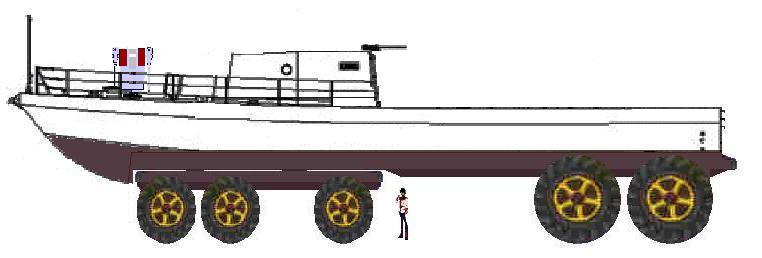 amongst other points, GRU TI; THRESHER, being the only one in port at the time, was literally picked up and thrown on shore. (Her sister ship PIKE was also thrown ashore, and SHARK and NARWHAL rode out their waves; the others did not).
amongst other points, GRU TI; THRESHER, being the only one in port at the time, was literally picked up and thrown on shore. (Her sister ship PIKE was also thrown ashore, and SHARK and NARWHAL rode out their waves; the others did not).Three days after, a truck driver arrived, claiming he'd been ordered to collect the hull of THRESHER; BM1 McMANN, BM2 JONES, and SNBM AUSTIN, later of Andaries infamy, chose not to allow him to do so. (The truth was the truck driver was a little rude to AUSTIN, who was assigned to PSU 314 at the time, and SNBM AUSTIN pulled and M-16 on he man; Petty Officers McMANN and JONES chose to back up their old shipmate- the three had served together at Station Vallejo- regardless what the truth was.)
With the tractor trailer impounded, Petty Officer JONES offered a wild solution- Mount what was left of THRESHER on the tractor trailer. SNBM AUSTIN, in a feat repeated many years later, actually cut THRESHER'S hull up perfectly to fit onto the trailer, then removed the cab of the tractor, reversed it's position relative to the kingpin, and rigged controls into the main deck area, converting THRESHER from a ship to a land vehicle. Her overall length had to be shortened, but with a 105MM Howitzer mounted in the former boat notch gave her some good combat capabilities in many ways.
However, Thresher was far too heavy for most combat operations, and she was restricted to rear areas. Her only major combat operation was in support of 104TH Infantry's attempt to hunt down a particular malcont faction (104TH Infantry had been assisting GRU TI during the first few hours of the Rain of Death against looters and rebels).
Generally, Thresher was not usable in combat, but more than capable of defending herself- A secret that many a malconts learned the hard way when they tried to take her on.
Unfortunately, Thresher's own history didn't fare well; She was abandoned and forgotten for over 100 years, with the damage of century in salty air and exposed to the elements badly damaging every part of the outside and the inside often flooded for months at a time, when some history buffs found her and formed the Thresher Society dedicated to restoring her. Funding shortfalls prevented them from being able to do so, but their efforts brought her to the attention of Terra Sector Authority (the Terran RDF), and they bought her for transfer to the Khyron KRAVSEEVA Militry Academy, where full restoration and permanent display became possible; In fact, she now serves in a limited role for Academy security, but this is mostly so the students can get hands-on experience with moddies.
In the picture above, you may note the presence of a man; This is actually an old photo of Admiral Richard HUNTER spliced in (for purposes of scale only). The forward set of wheels are from the tractor, the rear set from the trailer. Of the forward set of wheels, the rear set, also called the Number Three Wheels, were the original front wheels of the tractor, and the ones that permitted left and right movement (the turning wheels). They continued to do so; As the driver wants to turn right, the wheels turn left, causing the tractor to turn left, causing the rest of the body to fall behind to the right, pulling the whole vehicle right. The original rear axles of the tractor trailer were moved to the rear of the new overall vehicle, and the original trailer axles moved to the tractor; Thresher was, in fact, rear wheel drive, on a 'table' at the front to turn the vehicle. Also, you may note the stern part of the superstructure seems to be shorter than a 'normal' 87; This is because the stern of the superstructure was deliberately cut away, as was the 02 deck, to reduce weight (and because they were mangled pretty badly by the tidal wave).
Thresher's historical influence should not be casually dismissed; Between her and Lightbringer formed the basic theories necessary for the eventual development of the MTA-Titan and later UGC Landships, even if Louisa was the first major landship.
Name: THRESHER or Thresher.
Original Builder: Bollinger Shipyards.
Rebuilt by: USCG Group Treasure Island.
Model Type: Moddie; USCG owned 87' MARINE PROTECTOR-Class CPB/Tractor Trailer rebuild.
Class: Moddie/Land/Naval Tech.
Crew: 10
Passengers: Not more than 10 safely.
MDC By Location:
Crew Compartment-
Upper Arms (2)-
Normal Right Arm-
Modified Left Arm-
Upper Legs(2)-
100 (armor added to the outside of the cockpit)
40 each
50
25
40 each
Main Jet Engines (2)-
Laser Rifles (3)-
Heavy Laser Rifle-
M-89 Turret-
M-89 GatlinGun-
25 each
10
15
20
25
Range On Land: 25,000 miles.
Height: 20 feet.
Width: 19 feet 5 inches.
Length: 80 feet.
Cargo: About 1 ton.
Power Plant: Twin MTU 8V396TE94 Turbocharged Deisels.
Original Cost: $3.5 million.
Availability: One of a kind, so far as anyone knows.
Purpose: Anti-Personnel/Armor
Damage: Lead (Ball) shot: 7D6 Per round; Depleted Uranium rounds: 1D6 times 10 MD per round; Can be single or burst fired.
Rate of Fire: Single Fire: 1 Shot per pilot's attacks per melee. Full Auto Fire: 5 round bursts per pilots attacks per melee. (Can actually fire up to 5,000 times per melee, but soldiers are trained to fire in 5 round bursts.)
Range: 600 feet
Payload: Up to 500 rounds can be carried easily.
Bonuses/Penalties: Can only be fired in 5 round bursts, to a maximum of 200 rounds per minute; Though the gun can EASILY cycle faster than that, it overheats the barrel, causing it to distort and bullets to jam inside of the barrel, causing a pileup in the barrel; This leads to barrel breach, and 1D6 MD to the gunner and anyone around him (regardless the ammo type).
Weight: 50 lbs
Weapon Cost and Availability: 5,000credit; Occasionally available. Highly sought after, and made by a wide number of black marketeers.
Ammo Cost and Availability: Ball rounds: 800 to 1,000credit for a box of 50; Routinely available; DU rounds: Up to 100,000credit for a box of 50; Rare. Highly sought after.
2. Crews Weapons: The crew could still use their own weapons.
3. Ramming: Kind of a desperate maneuver, however the bow of the Thresher was specifically reinforced for this after the FIRST time she rolled over an obstruction in the roadway and suffered 22,000credit worth of damage to her nose.
Damage: 3MD per MPH.
Rate of Fire: Once per melee.
Payload: Conditionally unlimited; Each time Thresher rammed something, it would take 3D4 MD to the main body. This damage could easily be repaired, however.
Laser Cannons (4): This is the main weapon of the turret. Note: These guns fire in tandem, like pom-pom guns. If one barrel is damaged, reduce the damage and rate of fire FOR THAT ARM by half. Each gun must be targeting the same object as the other (can not be independently targeted).
Purpose: Anti-Aircraft/Ship
MD: 2D10 short burst, 4D10 medium burst, or 6D10 long burst.
Rate of Fire: 8 short, 4 medium, or 2 long bursts per arm per melee per gunner's attacks per melee.
Range: 10 miles
Payload: Unlimited
MRM Launcher Shoulders (2): A pair of MRM launchers mounted at the approximate position as the shoulders.
Purpose: Anti-Ship/Aircraft
Missile Type: Medium Range
Rate of Fire: Volleys of 1, 2, 3, 4, 6, 12 or all 24 per gunners attacks per melee.
Payload: 24 per launcher (48 total); Reloading takes about 5 minutes for a full reload (10 missiles take about 1 melee). However, Thresher didn't carry spare missiles.
20MM Vulcan Gatlin Gun: This gun is actually automated. The gunner activates the weapon by flipping a red switch under a cover on the control panel. The gun can NOT tell friend from foe, only whether an object is closing with the ship and how fast it is moving. If it meets certain criteria, the gun fires, throwing a wall of lead that either shreds the missile OR causes it to prematurely detonate.
Purpose: Anti-Missile Defense.
MD: 5D6 per blast.
Rate of Fire: Up to 6 per melee.
Range: 6,000 feet
Payload: 100 bursts.
- Radar: Military grade radar. Range 100 miles, can track up to 200 individual targets. 90% reliability.
- GPS: Standard tracking device.
- HUD: Displays maps, radar, targeting information, and any OTHER information the wearer wants directly in front of the user.
- Virtual Map: Displays a continuously-updating map of local terrain for the pilot. Effective land navigation of 85% as updates come. Good to 50 miles. Specific range can be adjusted in 1 mile increments.
- Loudhailer: Amplifies voice 1 to 100 times. 100' in normal crowds. the original loudhailer system was undamaged in the crash.
- 1 MC: An internal loudhailer, used to make announcements to the crew. The original 1 MC had to be replaced.
- Sound Powered Phone System: The original Ship's Service Phone system was damaged beyond any hope of repair, but the SPPS was repairable (only one line was kinked, but it did have to be replaced). The SPPS works, quite literally, by talking into it. It then carries the sound (more or less perfectly) over the circuit. (Word of advice, don't get into phone sex on the SPPS.)
- Combat Bonuses from Thresher Combat Elite:
- +5 strike.
- +1 dodge (by speeding up, stopping suddenly, and zig zagging).
RETURN TO TOP OF PAGE
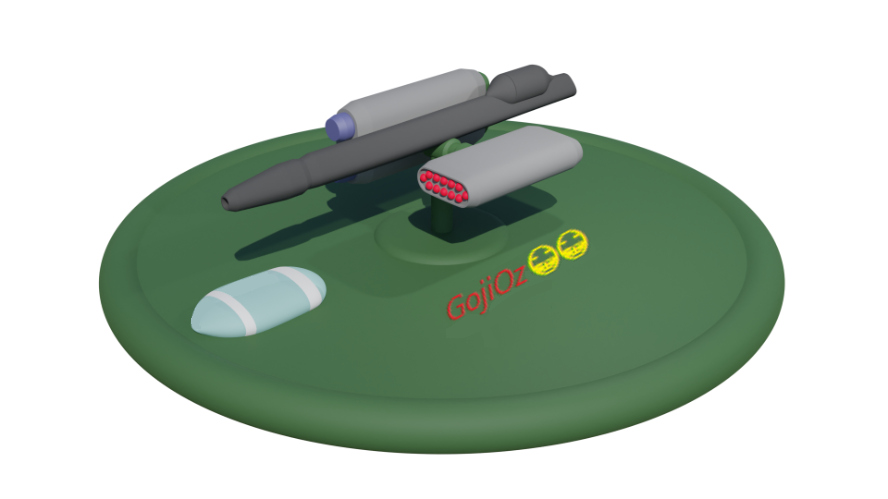 |
August JONES spent much of his childhood outside of Screeton Arkansas dreaming of hovering tanks. He realized in his teens that he could never build a hover system powerful enough to lift a tank without making it too wide and long to support infantry. He was 23 when Kara Qalliph Diel'are Kah Yar destroyed almost all around him, including the apartment build he had been living in. His parents home was spared, and he went there in the immediate aftermath.
Once there, he saw his various childhood models of hover tanks, most kitbashed from various toys. A few days later he found a wrecked T'sentraedi battle wagon (probably a SALAN-Class) and began trying to build his hovertank.
He began with a common hoversled, removing the rails and converting it to mi'cronne use. After cutting a hole in the upper deck he built a cockpit mainly from the face plate from T'entraedi battle armor. After a few test flights to ensure he understood what he was doing, the mounted the mast from a T'entraedi Delke Gadra (LRM launcher) off of a Serauhaug-Regult and removed one of the pods, replacing it with one of the Nilke Gadra (MRM Launcher) off of a Gluuhaug-Regult. With trial and error, he discovered how to reload the pods.
This competed, he ground down the stock, sights, grip, and trigger on a T'sentraedi Assault Rifle and rigged a solenoid from an 18 wheeler to the trigger. Around this he mounted components of Gluu-Ger and Serau-Ger armor cut and trimmed to best fit. Thus completed, August tried to reach out to the RDF for a buyer- To no avail. After a year's time he hadn't received even a hint of response.
August decided to take his tank abroad, hoping that by proving himself as a mercenry the RDF would try to hire him; He had arrived only intending to accept jobs from legitimate governments, but was consistently refused any offers. After a few months in Brazilia Quadrant, he finally landed a job running escort by a private party- One that didn't particularly want to discuss what they were moving. The majority of the 300 mile trip was completely uneventful, but at 20 miles from the destination they convoy was ambushed. August opened fire with the rifle and didn't stop until he ran out of ammo. Whether his clients noticed this or not was unclear, but upon arrival they expressed their thanks in part as 20,000 rounds of 37MM ammo. August wasted very little time converting the gun to accept 2,000 rounds.
August spent the next couple of years 'bumming' around Brazilia taking whatever jobs he could get; He actually did make a lot of money, but was unhappy at the situation; He wanted to be a militry tank designer- Not a criminal.
Rumors of the Badger tank got to RDF Intelligence; Posing as potential clients, 1138TH MP's approached August for a job; Once they confirmed they had their man, they began to detain him, only to be surprised as his response; "You're arresting me for what I tried to sell you?!" As his trial proceeded forward, August presented a very affirmative defense that he had done all of this to sell the tank to the RDF in the hopes of becoming a tank designer (including showing the court the many emails he'd sent to RDF headquarters, Armored Command, and various tank brigade and division CO's), and was eventually acquitted and hired. He continued to work on various RDF and later REF programs until his death in 2317, when the process of fully declassifying his personnel file began.
Badger's design influenced in many ways every RDF and REF armored non-Mecha to come after despite her relative crudity; The weapons were too high and too close together and the vehicle wasn't the most stable design, and the guns couldn't be trained independently of the tank (the whole tank had to be turned in the direction of the threat). It was generously described as "the Mother of tanks" (reffering the the British Mark I tanks of WWI) and less generously as "The RDF Semple Tank."
Badger now resides at the Fantoman War College, T'sentraedi City, Fantoma (or as it's more commonly known UGS BREETIA TUL).
RETURN TO TOP OF PAGE
 |
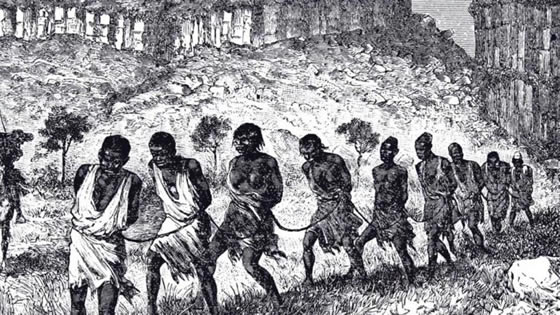 |
ANUL's slave traders used a pair of Boeing 777-300ERs sliced together lengthwise. The fuselage was stripped away, as were the wing and wing mounts, and "shelves" were installed along each side of the former fuselage- 2" staples being installed every 32" to clamp "passengers" in place. The former fuselage was replaced by a hardened steel pipe, capable of withstanding the diving pressures (she only submerged about 100 feet), but curiously the original aircraft's forward windows were kept intact. Underwater navigation was by dead reckoning, with occasional sonar pings to compare current depth to known depths of the ocean floor.
In the former aft cargo compartment the builders somewhat ingeniously installed the engines, these being jet turbines from a smaller aircraft, which powered a generator that turned the screws. On the surface, a pair of 25 foot folding masts with folding spars each were used to hold sails aloft, reducing fuel consumption and increasing the fresh air availability. These masts were only used at 20 miles from shore, with the first and last 2 hours of voyage being entirely submerged.
The boat was capable of transporting roughly 2,000 slaves at a time; She rarely made a voyage without loss, rarely less than 15%, and on one occasion 75%. The "cargo" was then sold in lots as high as 2,000credit a piece, with males fetching around 1,800credit and females as much as 2,500credit each. Sadly, ANUL's policies on slaves were the worst throwbacks imaginable, as males were routinely castrated and females raped- Those that still refused to "cooperate" were strung up in loose gravity-assisted ligature strangulation, meaning they were put on a slip-knot (not a noose by any definition) and allowed to strangle as a warning to others. Children above 5 were routinely killed in the same fashion. Africans, Arabs, Whites, and anyone else caught in their net were fair game.
Strangely, Mayflower was never intercepted, as the UEG was never aware of her existence; That smuggling, and specifically SLAVE smuggling, was occurring was not unknown, yet Mayflower in particular wasn't known to be a smuggler's ship- Despite the fact that the UEG was aware of her existence and thought they were aware of her activities. Her connection to ANUL was totally unknown, even after ANUL's final destruction. The boat's activities came out over a decade later, when her carcass was identified as such, and investigators, curious about why she was abandoned on a Chinese beach, boarded her, finding the conditions and deducing rather quickly what her purpose was. From there, the investigators searched for witnesses that would inform them of her activities. It is not known exactly how long she was in service, nor how many trips she made, but it is DEFINATE that she made an average of two trips a month with roughly a full load.
RETURN TO TOP OF PAGE
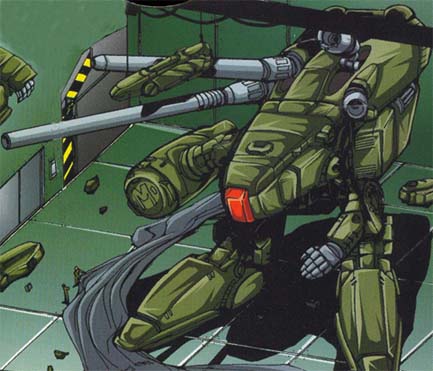 Essentially noting is known about this moddie other than that reported by Lt Dana STERLING; She observed the machine while held prisoner by surviving Robotech Masters.
Essentially noting is known about this moddie other than that reported by Lt Dana STERLING; She observed the machine while held prisoner by surviving Robotech Masters.The base frame was a MAC-II, the right arm replaced by a Spartan arm the left by a Gladiator arm. Two of the 40MM barrels had been removed, a third was clearly damaged (bent at about a 25 to 20 degree angle), the fourth appeared to be functional.
Lt STERLING reported that she only ever saw it in the mecha bay under apparent reconstruction; What became of the machine is currently unknown.
RETURN TO TOP OF PAGE
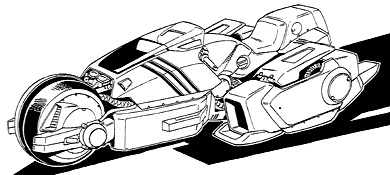 |
For reasons that would only become clear centuries later, Teddy added a large free spinning for and aft wheel; This allowed the bike to move along roads relatively easily on low power, and allowed him to maneuver the bike with the engines shut down. (Later on, the REF would realize that hover systems could be used as a target in an of itself, making them highly vulnerable; it is believed Teddy "might" have exploited a similar concept against the Invid.)
The thing DID work- Sort of. It was slow and difficult to maneuver, and targeting was more or less guess and check. The power plant was able to handle the drain for limited periods of time, but the vehicle had an effective payload of 10 shots per barrel, limiting effective combat time. If the cycle had been equipped with grav pods, a beefier power plant, and targeting systems, it is probable that this design may well have gained favor in many circles.
As this was discovered during the occupation time, no criminal charges could be brought against Mr. McCain, and as he was a "freedom fighter," his actions were excused and he was allowed to keep the cycle until the end of initial hostilities. After that he disappeared until the return of the Invid, whereupon he reappeared again as a "freedom fighter," and began attacking the Invid. After their second defeat, he went once again underground, taking his bike with him. No contact has been made with him since, nor was the bike been seen again for over 100 years; Dragon inspired the REF's PASS-451 Wyvern Assault Hovercycle, and was much more recently recovered, in relatively good condition, after the discovery of "Ted (Stephanie ST CLAIRE) McCAIN'S" last will and testament.
RETURN TO TOP OF PAGE
It should be noted that "MOST" modified weapons were utter failures, and these will not be reviewed in any great detail for simplicity.
Lights: "Lights" are pistol moddies, most of them by changing the caliber or by somehow combining two guns into one, typically using an over-under configuration.
The best example of this is the Lemat-07, though this particular example doesn't follow the naming tradition of "Lemat Light" as it previously existed. A .410-gge shotgun chamber and about 4" of barrel were mounted to 5.56MM revolvers; The shotguns were actually after-market attachments, both created by the "Brotherhood Of Steel."
Another example is the KINDLEY-AUSTIN Light, created by Jenny KINDLEY-AUSTIN of the Daisyline Camps and the first wife of notorious Anarchist-turned-Aggressor militiaman Booby AUSTIN (Colonel Jim TUNG'S pointman and Magor Jer FONTAIN 'S drinking buddy). A modified XM-29 Taser was strapped, Lemat style, to the underside of a GLOK 29 .40-cal pistol. Though the KINDLEY-AUSTIN Light was intended as a one-of-a-kind, the idea caught on with several groups, especially after the March to the Sea.
Heavies: Combinations long-arm systems; The most famous example is the FONTAIN Heavy, though the HOUSTIN-FONTAIN Heavy (an M-109 re-chambered for the more standard .50 cal bullet, then rigged with an under barrel 9MM UZI-Style sub-machinegun) and the VALTIN-AUSTIN Heavy (a cut-down AK-47 rigged with a modified 9MM machine pistol) were also part of the Anarchist armory. Some other examples include the SMITH Heavy (a 104TH Infantry moddy combining an RDF Light Laser Rifle with an RDF Heavy Laser Rifle), the JONES Heavy (a P-90 combined with RDF 9MM machine pistol), etc.
Vashs: Vashs are combinations of three or more long arms; Usually not very reliable, and most were more dangerous to the user than the target.
The only significantly successful example is the VALENTINE Vash, in which a FONTAIN Heavy-type 5.56MM Range Rifle with an underside .410-gge semi-auto shotgun was combined with a heavily modified US Army-Surplus flame thrower on the right side (Jessica VALENTINE was right handed, but found it more practical to use the flame thrower on the right side of the weapon after some trial and error).
Points: "Points" are combination of heavy weapons. One type, the Welcome Point, took an exemption of the standard naming protocol- USCGC POINT WELCOME lent it's name to the Welcome Point moddy.
RETURN TO TOP OF PAGE
 The second-generation Zatoichi was developed shortly after the Rain of Death with a button to hold the sheath in place, allowing it to be used both as a straight handled baton and as a sword. It's also equipped with a raised area near the hilt (where the sheath separates from the grip), to allow it to be inserted into a specially designed frog. In the picture to the right, one of the swords has been painted with red along the separation line between the sword and sheath, and on the button to be more easily discerned; Also, the grommet (which prevented the sword form slipping through the frog) was painted white specifically for this picture; Typically they were all black, no red, white, grey, or silver (excepting the blade, which was usually silver; A few were matted with silver edge).
The second-generation Zatoichi was developed shortly after the Rain of Death with a button to hold the sheath in place, allowing it to be used both as a straight handled baton and as a sword. It's also equipped with a raised area near the hilt (where the sheath separates from the grip), to allow it to be inserted into a specially designed frog. In the picture to the right, one of the swords has been painted with red along the separation line between the sword and sheath, and on the button to be more easily discerned; Also, the grommet (which prevented the sword form slipping through the frog) was painted white specifically for this picture; Typically they were all black, no red, white, grey, or silver (excepting the blade, which was usually silver; A few were matted with silver edge).Today, the RDF Zatoichi is fairly rare as well, at least as a 'practical' weapon, though is quite commonly carried for ceremonial purposes by many groups- The REF is not one of them, however.
Weight: 1 lbs.
Damage: PS doubled for sheathed, PS converted to MD for unsheathed.
Attacks Per Melee: Standard
Effective Range: Reach plus 3 to 4 feet, depending on maker.
Cost and Availability: Cost varies, but generally around 200credit; Poor availability for the first year or so after the Rain of Death, when manufacturing began picking up steadily; However, by then order had been restored sufficiently that the need for a "sword" as part of the police's weaponry disappeared. However, they remained popular with Private Security Forces (mercenries) well into the 23rd century, and as dress swords with some RDF's and militias to today.
RETURN TO TOP OF PAGE
Generally, failed moddies fall into a few categories:
- Outright Failures: Totally stupid, pointless, utter failures. The real, "What the fuck did you think you were doing?" stuff. Absolutely, without failure, the leader in this category was Kobold. Ostroc was another fine example of the "stupid is as stupid does" collection.
- Good Idea Gone Bad: Most failures fall into this category. Most bad ideas start as good ones, but somewhere along the way something failed- Usually critically. "Stalker" is an example here.
- Technical Failures: Good ideas that had limited capabilities; Short range, targeting issues, etc. "Dragon" was a good example of this group, though this assessment may be unfair (Dragon has to date not been recovered).
In fairness, some of these might be good designs with work (even Kobold might have been a good design, had FREEMAN been able to finish it- though nobody believes that).
His first mistake was getting into the moddy business at all. His second mistake was to use a Regult. His third cost him his life. 1138TH MP's 3RD Company First Platoon (Misappropriated Mecha Recovery/Undercover) and 4TH Company Second Platoon (Armored Response Team/Reinforced) tracked him down in Mexico City, where he was trying to sell it, and he refused to hand it over, trying instead to escape with it. He was shot with 5 MRM's.
The Kobold was originally a Raditzs Regult, but Mr. Freeman took the legs off and stuck them up on the thrust ports on either side of the main body. Mistake 1. He then removed the original weapons ("Stupid Zent pea shooters," he was reported to have called them) and replaced them with 4 966-PFG's. Mistakes 2 and 3. He also installed the MRM launcher from an Excalibur (mistake 4), but didn't hook it up (debatably mistake 5, but the failure to properly install it prevented it from being used and damaging the Mecha). Finally he installed an M-135 gun turret to the underside of the torso and additional armor inside the cockpit (generally regarded as his only SMART moves).
Reinstalling the legs as he did negated the pods ability to swivel; The 966-PFG's were unable to train properly as they could not be mounted in place securely and were more or less fixed forward only, limiting field of fire. The 966's were also too powerful for the only kinds of targets they COULD be trained on effectively, infantry and vehicles, and they were generally referred to as his "million dollar ankle biters." The MRM launcher back blast, if it had been installed correctly, would have knocked over the Mecha, and gave it a taller profile, making it better target.
The Kobold would have been tragic, if it weren't so pitiably funny.
The failure of this moddy was power- It didn't have any. It is my understanding that the maker intended to obtain OBP's power plant (the XXXXXXXXXX) from an associate in the black market, install this in a compartment built for it there, and then sell and/or field them, but was never able to do so as we took it away from him too soon.
RETURN TO TOP OF PAGE
Simply put, the arms were too heavy for the attachment points, and they broke off in combat after extended fist fighting. The theory, of course, was that the arms added a little more firepower, and expanded on hand to hand combat options.
Though technically a successful design to SOME degree, it is a clear example of what not to do. It did however lead to the development of the Garudan Locust Robot, which is in service to this day.
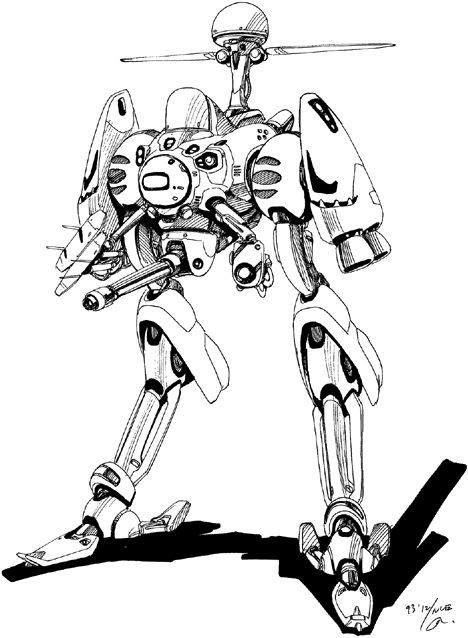
RETURN TO TOP OF PAGE
In theory, this configuration would have worked well. In theory. The practice, however, left MUCH to be desired. The EP-1 drew too much power from the power plant, as well as the Laser Cannons, though this was NOT the Achilles heel of the Mecha. Properly rationed, the Mecha COULD have overcome these issues.
The ROV-10 couldn't get at any target on the left side of the main body with the EP-1 in the way, and the EP-1 couldn't traverse. The missile pod had a full load, but of inferior missiles, and T'sentraedi missiles at that (for which the pods had NOT been designed).
The entire left side, therefore, was under-protected (though not wholly unprotected), leaving that flank weak and exposed. This, in the end, was to prove her undoing. 1138TH MP's 3RD Company First Platoon scooped her up in a bar in Mexico City shortly after 212TH Mechanized neutralized her Mecha. She was, it seemed, trying to obtain a new Destroid (in specific, she was attempting to get a Gladiator or possible one of the hybrids). She was later sentenced to life imprisonment.
RETURN TO TOP OF PAGE
The damned thing could BARELY move at all, and then only in short, choppy movements at a slow bell. Worse still, the ball turret was difficult to properly control, and the gun clusters on the sides of the head didn't work in tandem. Lastly, it was tall enough to draw attention to itself, but had HUGE open flanks, and the underside was totally unprotected.
The ran afoul of some malconts in the Joaquin area (South America) and their bodies were discovered near the burned-out wreck. Their identities were never determined.
Besides the fact that the whole thing was quite funny, there were several practicable problem with it;
- All the parts were worn down, and consequently the creation was slow and ungainly.
- The reactor was NEVER meant to take the kind of strain being demanded of it.
- The Spartan missile pod was FAR too heavy, so it had to be set in one particular position and welded into place; Because of the back blast, the only way it could be positioned was pointing straight up, where a missile would have to streak back DOWN just to find a target. This gave an enemy several minutes to decide what to do.
RETURN TO TOP OF PAGE
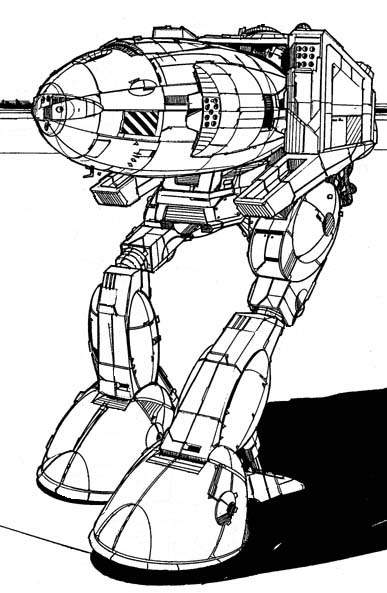 The Stalker started life as an OBP, but the owner removed the weapons arms and overhead PBC (these may already have been gone). She then added missile launchers from a LAP to the rear of the Mecha, giving it additional firepower. However, the additional firepower didn't to justify the effort, and this is, technically, a success story gone bad.
The Stalker started life as an OBP, but the owner removed the weapons arms and overhead PBC (these may already have been gone). She then added missile launchers from a LAP to the rear of the Mecha, giving it additional firepower. However, the additional firepower didn't to justify the effort, and this is, technically, a success story gone bad.Mz JONES attempted to deploy Stalker in South America and Africa in support of other malconts, with special emphasis to urban/city environments; A clever trick, since her unrestricted ability to fire in the cities permitted her to fire, yet RDF Mecha couldn't fire back, due to collateral damage- Usually.
Unfortunately, Mz JONES rarely went up against the RDF, and her typical enemies didn't care about 'collateral damage.'
Both the pilot and her machine disappeared shortly before the Pioneer Mission began- A certain Corporal SMITH during the Optera War had a tendency to smash through everything in her path, especially building- A tactic Mz JONES was infamous for. She died in Haydon IV. Stalker herself has never been recovered, and it's believed she ended up in a scrap yard.
REF R&D's assessment of Stalker, based on the limited data available on her, determined this 'very clever' concept should be followed up on in a later design, and the Zulu Destroid integrated some of the features in the "Gunslinger" configuration, and these have proven largely successful.
Stalker did have some definite advantages; First and foremost, the additional missiles practically multiplied the potential power-to-target; Also, based on gun camera footage, it's believed Mz JONES added more armor, probably inside.
However, her lack of defensive and short weaps left her horribly vulnerable, especially to infantry. This was a weakness that most major groups knew of, and exploited to the best of their abilities- 104TH Infantry once almost had her, when they rigged a bunch of claymores in a street she was about to head down- But JONES suddenly shifted her attack, and the ambush failed. JONES knew this weakness, and made every effort to avoid this problem.
RETURN TO TOP OF PAGE